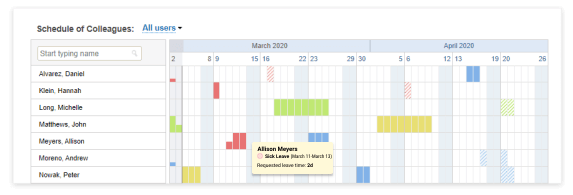Absence management is not easy for employers in the healthcare industry. Firstly, most care providers have flexible schedules, which complicates attendance and leave monitoring. Secondly, the absenteeism rate is very high across hospitals, and the need to find a balance between quality patient care and employee satisfaction is always there.
But besides these two major absence management difficulties, employers have some more. How to enhance absence management while curbing the ever-increasing administrative costs? How to ensure an optimal level of team performance in case you want to provide additional leave time to sick or ill employees? These absence management needs and problems in healthcare are discussed below along with the benefits of using a robust absence vacation tracker.

Schedule Flexibility
The main goal of scheduling is to allocate the right amount of human resources for the tasks at hand. When designed properly, a schedule minimizes the time and costs of service and guarantees an excellent quality of healthcare.
However, the level of workloads in the many medical facilities (especially the emergency ones) changes from day to day, depending on the number of patients visiting. Thus, it may be hard to predict how many practitioners must be present on a shift in order to satisfy every patient’s need. At the same time, hospitals generally don’t like to schedule too many employees for a shift since this entails to higher labor expenses.
To improve the utilization of human resources and enhance the quality of care, it’s pivotal for a medical facility to have a flexible approach to scheduling. This is particularly important for places that employ on-call shifts. When a nurse or a physician is required to be available at the workplace on short notice, they enjoy lesser predictability, and their work-life balance suffers. As a consequence, the rate of absenteeism and staff turnover goes up too.
Schedule flexibility is the key to avoiding that – if you let healthcare professionals swap shifts when needed and give them more opportunities to focus on personal needs, the team becomes happier, and the number of unplanned absences gets lower in the long term.
Can’t refuse on-call scheduling? Make sure to modernize and make it more convenient for your workers by using a specialized software tool, such as Spok. With its help, you can quickly update the schedule for the entire team, and your staff members will always have access to all the essential information about the changes in their on-call shifts.

The Cost of Leave Management
Time off management is practiced by every business regardless of its primary function and sphere of performance. Like everyone else, healthcare organizations are obliged to comply with national and state time off rules, such as the Family and Medical Leave Act (FMLA), and provide employees with the legally demanded amount of leave time per year.
At the same time, time off policies vary greatly across medical facilities and may take a plethora of diverse forms:
- Some offer merely unpaid days off to employees, while others provide up to four weeks of paid vacation time.
- Some separate personal leave days and sick days, and others integrate them into a single bundle.
- Some set specific limits on the amount of leave time one can take per month or year, while others give employees an opportunity to earn additional days off.
But despite an organization’s approach and policies, leave management remains a significant administrative process, whereas such practices as time off accrual and leave balance tracking to incur a lot of overhead costs.
Every quality-oriented hospital aims to reduce administrative expenses since they don’t add any direct value to patients. And in the United States, the problem of the healthcare-related administrative cost burden is especially prominent compared to other countries, and it can be eliminated merely by addressing the unnecessary administrative complexity in the industry. The latter calls for a need to simplify all the organizational procedures, from medical record-keeping to billing and payroll.
In this situation, streamlining time off tracking and leave requesting is a small yet effective step towards lowering overhead costs. And today, hospitals can apply some software tools in order to achieve that. Assume actiPLANS as an example. This smart absence vacation tracker accrues time off automatically and accelerates the approval of leave requests considerably. With actiPLANS, data collection becomes error-free, and the picture of everyone’s absences gets fuller and clearer, facilitating the management process significantly – all this contributes to greater cost efficiency.

Sick Leave Management
Care providers face an elevated risk of sickness and injuries working in medical facilities every day. Intense workloads and an extremely high pace of performance also cause stress and adversely affect their psychological well-being. Hence, absenteeism due to disease is a frequent occasion in hospitals. But when an ill employee needs an extended number of days off to restore health, an employer finds themselves in a difficult position – How to avoid workforce shortages and extra costs but still be fair and compassionate towards your staff members?
Some employers go the easy way and apply no-fault attendance policies, which imply that an employee accrues points for each unplanned absence, regardless of the reason behind it. When a particular number of points is accumulated within a given period, one is subject to discipline or even contract termination.
The thing that makes this method so simple to use is that a manager doesn’t need to communicate with a care provider and clarify why the latter can’t attend the workplace as often as expected. However, no-fault attendance policies contribute to higher employee dissatisfaction and, moreover, violate the FMLA and the Americans with Disabilities Act in case an employee’s absence is due to a serious disease.
To avoid troubles, employers in healthcare can implement a more personalized approach to leave management and track reasons for employees’ absences more precisely. With actiPLANS, for instance, employees may identify why they can’t attend work for any given day, whereas managers can review who’s absent, for how long and why. In this way, it’s possible to ensure that your leave management practices are not in conflict with the employment laws.

Absenteeism Prevention
Sickness and illness are not the only reasons for unplanned absences among healthcare workers. They can also be caused by:
- Adverse working conditions,
- Lack of supervision,
- Reduced motivation,
- Poorly communicated performance expectations,
- Unfavorable workplace culture, etc.
Hence, to prevent the immense costs of absenteeism, including those linked to low healthcare quality, hospitals have to consider multiple factors at once and implement holistic strategies addressing the following:
- Organizational absenteeism policies must aim to align the culture and needs of a hospital, as well as clarify attendance expectations, time off accrual rules, disciplinary procedures for unplanned absences, etc.
- Incentives and bonuses should be offered to employees as a means to motivate and reward them for excellent performance and promote better attendance.
- Favorable workplace conditions must be created with an emphasis on the prevention of employee burnout through more efficient staffing and scheduling practices.
A Smart Absence Vacation Tracker to the Rescue
Needless to say, without a well-functioning absence vacation tracker, an employer will struggle to regulate absenteeism effectively. In addition, SHRM recommends businesses to promote longer planned vacations among workers since unplanned and shorter-term absences are the thing that induces costs most.
Vacation planning and tracking are easy with actiPLANS. The tool lets users keep tabs on their time off balances and offers a flexible approach to leave requesting and approval. Moreover, this smart absence vacation tracker enables managers to run multiple reports to review their teams’ time off trends and absence history. In this way, it fosters more informed and effective decision-making.



